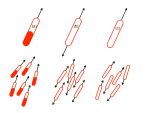EPJ E Highlight - Enigmatic Nematics
- Details
- Published on 31 October 2012

The law of hydrodynamics governing the way internally driven systems behave could explain their complex structure
Physicists use hydrodynamics to understand the physical mechanism responsible for changes in the long-range order of groups of particles. Particularly, Aparna Baskaran of Brandeis University, Massachusetts, USA, and Cristina Marchetti of Syracuse University, New York, USA, focused on ordered groups of elongated self-propelled particles. They studied the breakdown of long-range order due to fluctuations that render them unstable and give rise to complex structures, in a study just published in EPJ E within the topical issue on Active Matter.
The authors coined the term self-propelled nematics to refer to internally driven elongated particles that spontaneously align head to tail, like tinned sardines. These are characterised by an ordered state that is stationary on average. This means that there is a long-range order, i.e., the long axes of the molecules tend to align along a preferred direction, whereas the locally preferred direction may vary throughout the medium due to local strains or disturbances.
In this study, Baskaran and Marchetti first found that a uniform nematic state can be disturbed by density fluctuations associated with an upward current of active particles. Since the density in turn controls the onset of nematic order, this phenomenon is self-regulating and universal.
They also found that an instability can be triggered by a local distortion of particles’ orientation. Such a distortion results in local currents that in turn amplify the distortion, leading to an instability deep inside the nematic state.
Future research will involve solving numerically the hydrodynamic equations to test the theory presented in this study and characterise the emergent structures. Ultimately, this work may help us gain a deeper understanding of pattern formation and dynamics in a variety of internally driven systems, from epithelial cells and soil bacteria such as Myxococcus xanthus, to colloidal self-propelled nanorods.
Self-regulation in Self-Propelled Nematic Fluids. A. Baskaran, M. C. Marchetti (2012), European Physical Journal E 35:95, DOI: 10.1140/epje/i2012-12095-8




